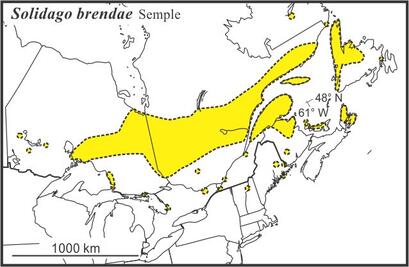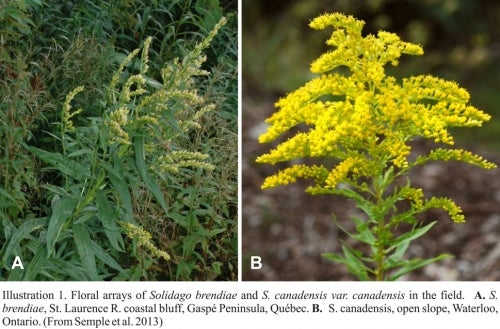Department of Biology
ESC 350
200 University Ave. W
Waterloo, Ontario, Canada N2L 3G1
Phone: (519) 888-4567 ext. 32569
Fax: (519) 746-0614
Brenda's Goldenrod
Solidago brendae Semple (2013) is the most recently described species in S. subsect. Triplinerviae. Fernald (1915) treated the taxon as S. lepida var. elongata (Nutt.) Fern., which was a misapplication of the name S. elongata Nutt. to this species native to eastern Canada. It is common in the Gaspé Peninsula and along the north shore of the St. Lawrence R., in northestern Québec. It occurs in western Newfoundland and in scattered locations in New Brunswick, Prince Edward Island, and Cape Breton, and Nova Scotia in eastern Canada. It is known from several locations in Maine and possibly occurs in northern Maine as well. The range extends across northern Quebec toward James Bay in scattered locations and is native or introduced in scattered locations in northern Ontario as far west as Red Lake. Semple and Gilman (2015) reported the presence of S. brendae in northern Vermont. The species was not included in Semple and Cook (2006, Flora of North America). Semple (2020) discussed why the name S. brendae has been taken up here rather than the original form of the name S. brendiae as published.

Solidago brendae is distinguished from S. canadensis by the branching pattern of its inflorescences and by having usually much longer upper leaves that extend into the inflorescence and heads with more ray florets. Leaves can have large sharp serrations or be entire. Solidago brendae appears to replace S. canadensis north of roughly 46° N latitude.

Solidago brendae is similar to S. fallax but has narrower middle and upper stem leaves. Semple et al. (2013) presented a multivariate morphometric analysis that helped determine which technical characters distinguished these three eastern species from each other and from the more western S. lepida and S. elongata.
Solidago brendae is a diploid species occurring on calcareous sand and gravel soils, sandy clay loam soils along stream margins and banks, road sides and wet ditches, recently cleared land, disturbed ground, gravelly shores. Semple and Chmielewski (2022) determined that many chromomsome counts published under the name S. canadensis were actually counts for S. brendae, and they revised the distribution and mapped the locations of 70 counts.
The species is named in honor of Brenda Semple the author's wife and companion on field trips for more than four decades and was co-collector of the type specimens Semple & Semple 11437 (WAT, MO, MT, UNB).
Semple (2016) documented a Solidago bicolor × S. brendiae hybrid using multivariate morphometric analysis of specimens of S. bicolor, S. brendae and S. canadensis. The hybrid was first reported by Hinds (1984) as S. bicolor × S. canadensis; the subsect. Triplinerviae parent was actually S. brendae. Semple (2020) documented a Solidago brendae × S. sempervirens hybrids using multivariate morphometric analysis of specimens of S. brendiae, S. canadensis and S. sempervirens.
Solidago brendae, habit, Semple 11434, Gaspé, Québec
Solidago brendae, type, Semple 11437, Gaspé, Québec
Solidago brendae, leaf serrations, Semple11471, Prince Edward Island
Solidago brendae, small S. elongata-like inflorescence, Semple 11437, Gaspé, Québec
Solidago brendiae, lax inflorescence, Semple 11434, Gaspé, Québec
Solidago brendiae, heads, Semple 11434, Gaspé, Québec
Floral arrays of Solidago brendiae and S. canadensis (Semple et al 2013)
Brenda holding Solidago brendae, Baie-Comeau, Québec
Solidago brendae range Semple draft 2022
Semple, J.C. 2013. A new species of Triplinerviae goldenrod in eastern Canada (Asteraceae: Astereae): Solidago brendiae. Phytoneuron 2013-57: 1–9.
Semple, J.C., H. Faheemuddin, Y.A. Chong, M.K. Sorour, J.A. Hood, I. Khamis, Y. Ma, and K. Kornobis. 2013. A multivariate morphometric study of the Solidago canadensis / S. lepida complex of Solidago subsect. Triplinerviae. I. Northeastern taxa (Asteraceae: Astereae). Phytoneuron 2013-58: 1–20.
Semple, J.C. and A.V. Gilman. 2015. Solidago brendiae (Asteraceae: Astereae) in Vermont. Phytoneuron 2015-40: 1–7.
Semple, J.C. 2016. Documenting a Solidago bicolor × S. brendiae hybrid (Asteraceae: Astereae) from Nova Scotia. Phytoneuron 2016-23. 1–10.
Semple, J.C. 2020. Documenting a Solidago brendae × S. sempervirens hybrid from the Gaspé, Québec (Asteraceae: Astereae). Phytoneuron 2020-4: 1–8.
Semple, J.C. and J.G. Chmielewski. 2022. Cytogeography of Solidago ser. Canadenses (Asteraceae: Astereae): S. brendae, S. canadensis, S. elongata, S. fallax, S. lepida, S. rupestris, S. shortii, and S. turneri. Phytoneuron 2022-57. 1-17.
Revised 2 June 2023 by J.C. Semple
© 2023 J.C. Semple, including all photographs unless otherwise indicated













